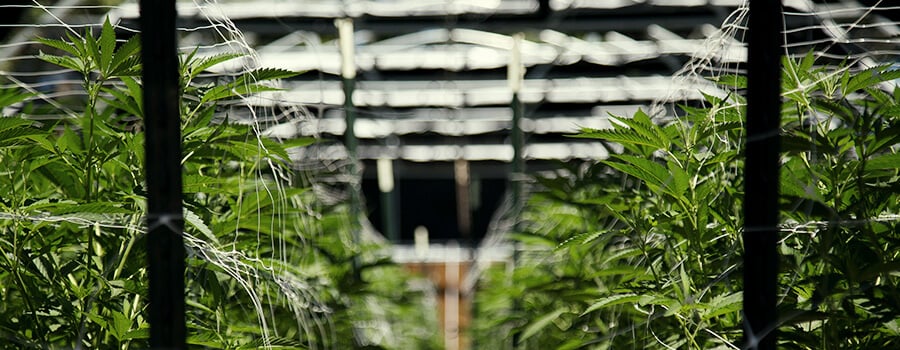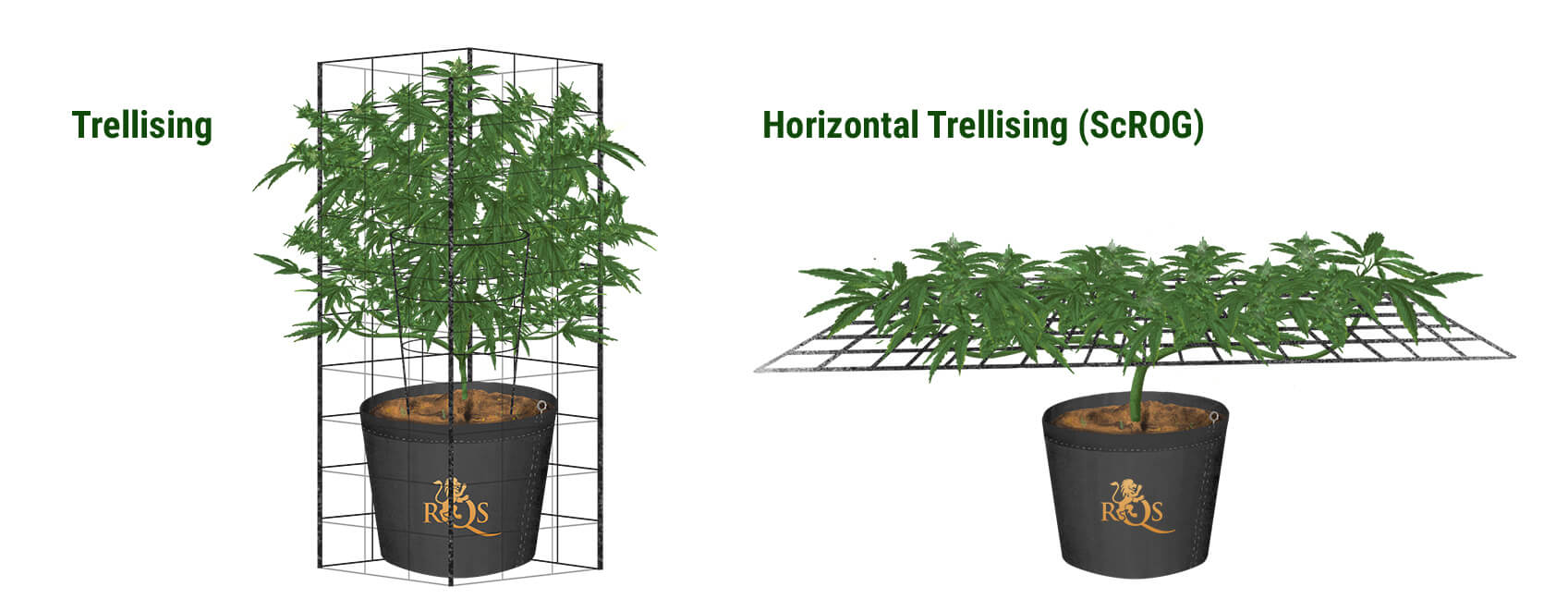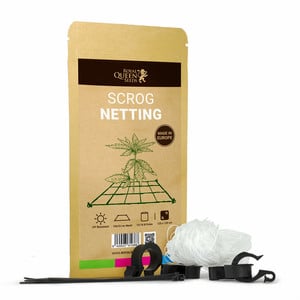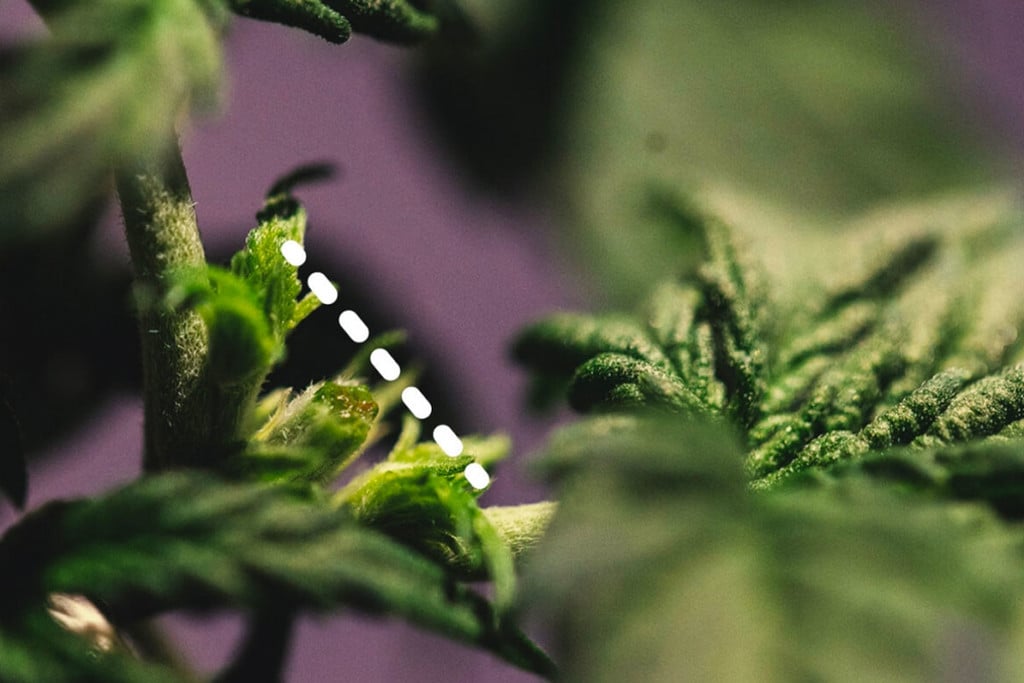.

The Art Of Cannabis Trellising
No matter how or where you grow your ganja, you could be harvesting more weed if you used a trellis. If you want to crop the marijuana mother lode, you need to know about the art of trellising.
Contents:
What Is A Trellis?
A trellis is a framed screen or net with a lattice pattern. It can be positioned vertically or horizontally to maximise available grow space and light penetration in any cannabis garden. Indoors or outdoors, there is always a place for a trellis. The idea is to bend and weave shoots through the gaps in the structure. This allows the grower to dramatically increase yields. More shoots equals more fruits. Plus, a trellis allows the grower to manipulate plant growth and alter the pattern to best suit the cannabis garden.


The Origins Of Trellising
The truth is, nobody really knows when trellising was invented or by whom. We have references to trellising from ancient Roman times. So perhaps the Romans deserve the credit? Or maybe they conquered and killed the folks that did and took over the gardens? In any case, we can be certain that its resurgence in Europe coincided with the rise of espalier during the Renaissance. Espalier would later inspire LST.
Legendary French landscape architect Andre Le Notre designed the gardens at the palace of Versailles, and he was a big fan of trellises. In fact, trellises are everywhere, adorning both the interior and exterior of much of the palace, purely as decoration. Unsurprisingly, this style of architectural design is known as trelliage.
How To Trellis Cannabis
These days, you can buy or build a trellis for a very low cost. Outdoors, wooden posts and frames are common materials for their durability. Indoors, nylon and plastic are the materials of choice. Either way, the principle remains the same. It’s just a mesh screen at the end of the day. How tough it needs to be is contingent on the growing environment and the size of your plants. But netting can work just fine indoors or outdoors, so long as it is tightly secured in place.
The only barrier to entry is an adequate level of hands-on cultivation skills. Trellising goes hand-in-hand with a variety of pruning and training techniques. Topping, LST, defoliation, and lollipopping are essential to getting the most out of your trellis. Don’t mess with a trellis until you’ve got the skills and time to manage it. Trellising is a labour-intensive business.
Vertical Trellising
The “living wall” concept can be applied to cannabis with a vertical trellis. Outdoor growers are more likely to use this method. Outdoors, a vertical trellis attached to a wall will promote vine-like vertical growth. Indoors, the vertical trellis is less common. However, it is used in cylinder-shaped custom grow-ops. These units are aimed at commercial growers housing hundreds of plants tiered along the outer walls with the grow lamps positioned in the centre.
Horizontal Trellising aka The ScrOG Method
The ScrOG or screen of green method is the standard horizontal trellis favoured by indoor growers. For those that want a comparable, and sometimes superior, harvest to a SOG, but from far fewer plants, scrogging is a must. Practised pruners and plant trainers that want to take yields to the next level will always drop a ScrOG on the crop.
Vegetative growth is the time for bushing out cannabis plants. Usually, a couple of weeks before the transition to bloom, the grower will install a screen with 5cm square gaps just above the plant canopy. This is only the beginning. The process of bending and weaving shoots to fill out this screen will continue perhaps until mid-way through flowering.
Below the screen, growth must be thinned out. This involves stripping away leaf material followed by lollipopping around week 3 of flowering. Plant energy is focussed on bud production in the sweet spot above the screen. Growers must ensure the optimal light distance is maintained and as many colas as possible are illuminated. Defoliation above the screen must be strategic. You don’t want to stress your plants, but you don’t want flowers shaded by fan leaves. Trimming should be an ongoing yet minimalist process.


How To Trellis Cannabis Outdoors
To set up an outdoor cannabis trellis, you’ll need some specific materials that might not be necessary when using the SOG or ScrOG method. This is because outdoor plants can get incredibly big and top-heavy, meaning they'll need some serious support. Given the extra size and mass they gain when trellised, it’s imperative to ensure that your structure can handle them.
Whereas horizontal trellising is more commonly used indoors, vertical trellising is more common outdoors—or a combination of vertical and horizontal. Exactly what you’ll opt for depends in part on the size of the pot. Bigger pots mean bigger plants, as the roots have more room to spread. It’s also important to choose a pot with enough surface area and weight to keep a fully grown plant upright. Outdoors, plants can get so top-heavy that they topple over, and this sort of stress can seriously impact your yield.
To fix the plants into the structure, you’ll pinch and bend their branches as they enter the flowering stage. They’ll be able to repair themselves, so don’t worry too much—although you certainly don’t want to snap them. These branches will then be bent and woven through the trellis so that the end of the shoots poke out. You can use cable ties to loosely attach them, but make sure these don’t become too tight as the plant grows.


Step-by-Step Instructions for Outdoor Cannabis Trellising
There’s a process to outdoor trellising, and while it’s not too complicated, it is involved. So make sure you have the time to properly tend to it.
What You’ll Need
- Large fabric pots
- Tomato cages
- Wooden/PVC/metal poles
- Trellising and outer caging (metal or plastic mesh)
- Cable ties
Directions
1. Instal a tomato cage in the centre of the grow bag. Do this at the time of transplanting. This will act as an internal support system.

2. Instal the poles as the four corners of a square around your grow bag. Make sure these are tall enough to support your plant at its final height, and have enough extra length to be buried deep into the ground. These will support the whole structure, so they must be strong and secure.

3. Instal the horizontal trellis. The first layer should be placed above the top of the tomato cage before the plant reaches it, as you want it to grow through the holes, though you may need to use some low-stress training to help it achieve this. Secure each corner to one of your four posts. Again, this must be secure as it will support the weight of the branches. Use strong cable ties or something else robust. Depending on the size of the plant, you may want to instal a secondary horizontal trellis later in its life cycle.


4. Instal the outer caging. This is to support lateral growth. Using a similar method to horizontal trellis techniques, attach this vertical mesh to the outside of the four posts and secure it well. Leave a big enough gap at the bottom to get in there and tend to your plant. Instal this nearer to the end of the life cycle.

5. Tend to your plants. This must be ongoing throughout the grow. To make trellising work, you will need to regularly and carefully maintain your plants as they grow. You must use LST to direct the plant's growth, and support it accordingly as it grows. Likewise, regular defoliation must take place. By thinning the leaves, you increase air circulation around the plant, minimising the risks of pests and mould. However, this must be gentle as you don’t want to stress your plant, nor do you want to minimise its ability to photosynthesise.


Benefits of Using a Cannabis Trellis
If you trellis your crop properly, you’ll have huge plants with comparably huge yields. If you’re serious about growing cannabis, some form of trellising is a must. The added growth and increased exposure to light allows for the development of monster buds. By giving them something to cling onto, you give their branches the necessary support to develop swollen buds that would cause the plant to break under natural conditions.
Marijuana trellis benefits at a glance:
- Equal light distribution
- Supports heavy buds
- Optimises time and space
- Supports more and bigger colas
- Encourages better airflow for the plant
Outdoor Weed Trees
The weed trees of Southern Oregon take trellising to the max. Limited to 6 plants for medical patients and to just 4 plants for recreational users by state law, Oregon growers have to make the most out of their crops. Master marijuana growers like Lambsbread cultivate 3m+ tall monsters with sprawling, flat canopies that are almost as wide. His giant cannabis plants are so humongous, he needs a ladder to fit a trellis.







































